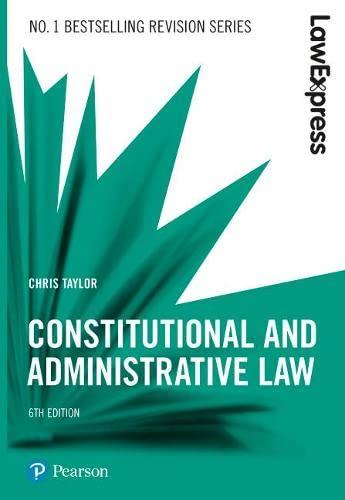Question
1) The purpose of the Truth-in-Lending Act is A)to ensure that consumers are not charged too much interest. B) to protect consumers from hidden product
1) The purpose of the Truth-in-Lending Act is
A)to ensure that consumers are not charged too much interest.
B) to protect consumers from hidden product hazards.
C) to prevent discrimination in the extension of credit.
D) to enable consumers to make more informed decisions about credit.
2) What category is not included in a Truth in Lending Act Disclosure Form?
A)Annual percentage rate
B)Finance charge
C)Amount financed
D)Current standard interest rates
3)Occasionally, a consumer may believe that his or her bill contains an error. This is
also covered under Regulation Z, and should be covered in the ''___'' section of the bill the consumer receives.
-Free Response-
4)Violations of the Truth in Lending Act can result in criminal liability.
A) True
B) False
5)In certain circumstances, TILA allows borrowers to cancel a contract for up to 3 years after it was entered into.
A) True
B) False
6)Maggie disputed a piece of information about her in a credit report prepared by WRT, Inc., a professional credit bureau. WRT investigated the information, but does not agree with Maggie's position. Maggie has subsequently filed a statement setting forth the nature of the dispute. WRT has no grounds to believe that Maggie's claim is frivolous, but also does not agree with it. In subsequent credit reports, WRT
a)must remove the disputed information altogether.
b)must accompany the disputed information with a note that Maggie disputes it and provide Maggie's statement or an accurate summary thereof.
c)must accompany the disputed information with a note that Maggie disputes it, but does not need to include Maggie's position.
d)may print the disputed information without comment.
7)Under the Fair Credit Reporting Act, consumers have the right to see their credit files.
A) True
B) False
8)Under the Fair Credit Reporting Act, consumer reporting agencies must use reasonable procedures to verify that users use the credit report for legitimate business purposes.
A)True
B)False
9) FACTA also requires the truncation of account numbers for credit cards and debit
cards on a customer's receipt, using only the last______digits of the account number,
preceded by a series of Xs.
-Free response -
Step by Step Solution
There are 3 Steps involved in it
Step: 1

Get Instant Access to Expert-Tailored Solutions
See step-by-step solutions with expert insights and AI powered tools for academic success
Step: 2

Step: 3

Ace Your Homework with AI
Get the answers you need in no time with our AI-driven, step-by-step assistance
Get Started


